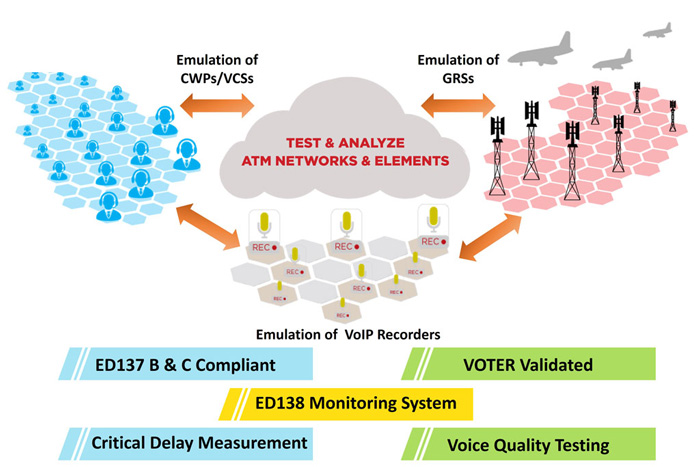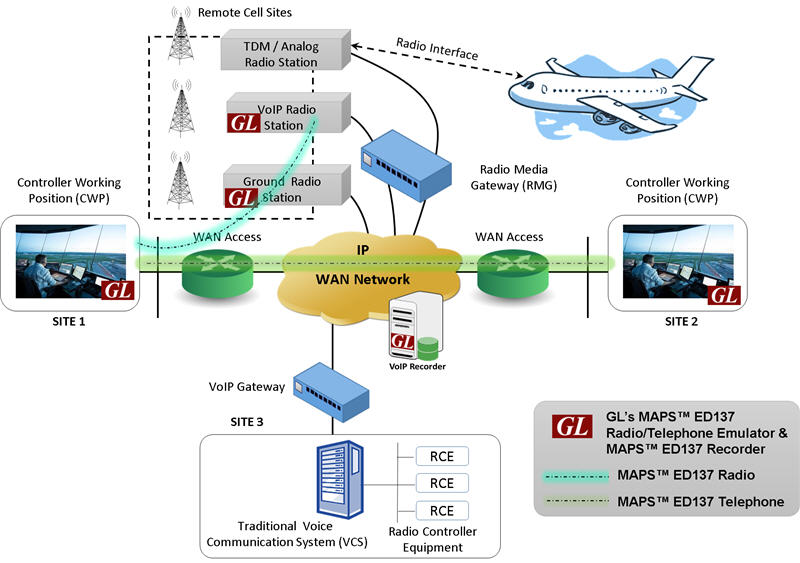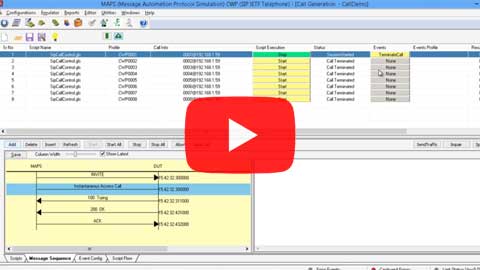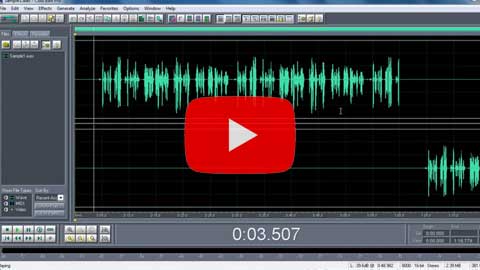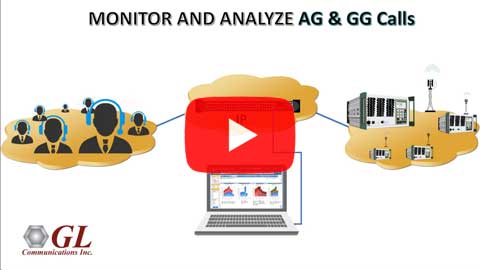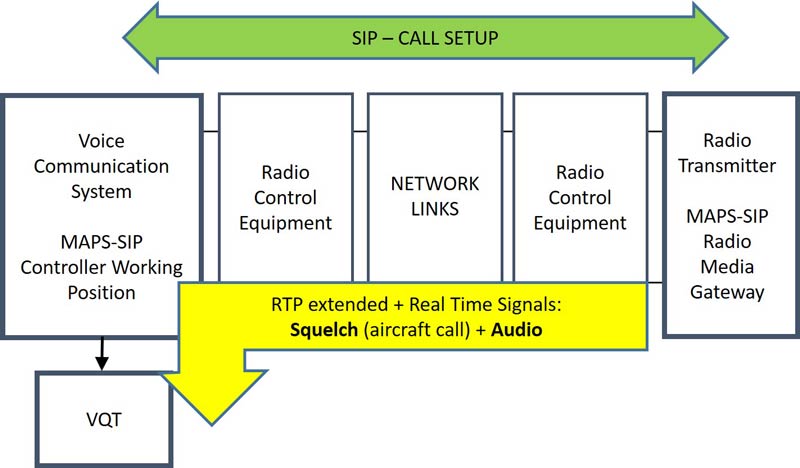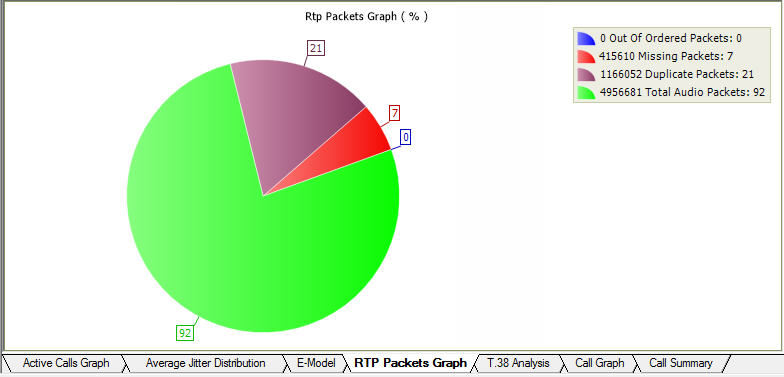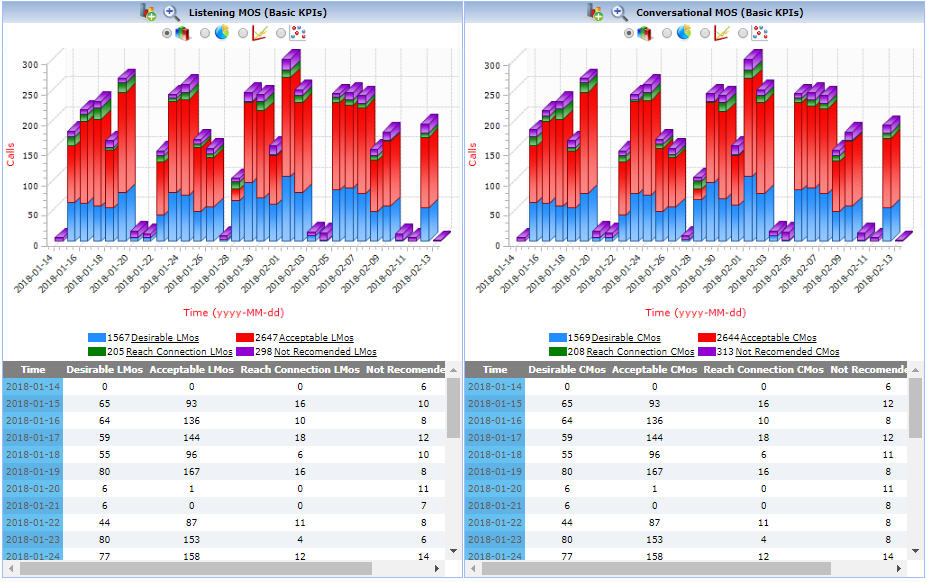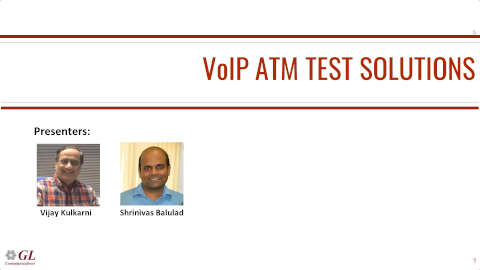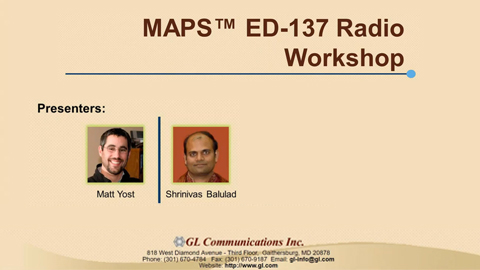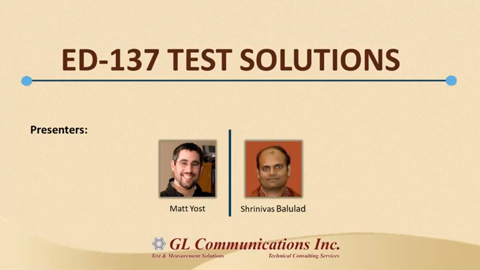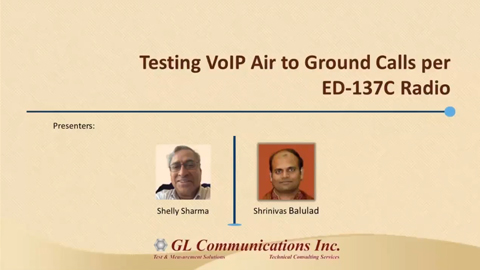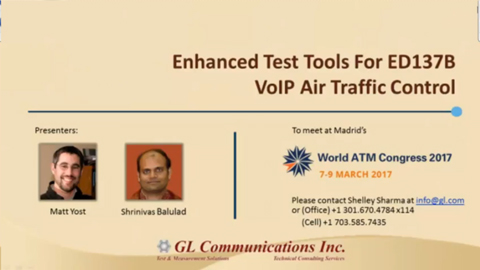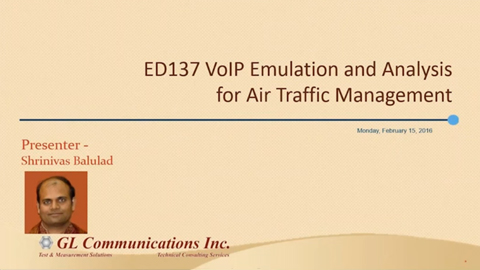Testing ED-137 and ED-138 Interoperability Standards for VoIP Air Traffic Control
ED-137 Protocol emulation, delay measurements, Voice Quality Testing and ED-138 Monitoring Solutions.
Request a Demo / QuoteATM Test Solutions MAPS™ ED-137 Radio
MAPS™ ED-137 Telephony MAPS™ ED-137 Recorder
Overview
Air traffic management (ATM) voice communications, whether Air-Ground (A-G) or Ground-Ground (G-G), were traditionally TDM-based. With the EUROCAE ED-137 interoperability standard, VoIP can now be used for air traffic control, utilizing SIP to manage sessions within an Air Traffic Services Ground Voice Network. SIP-based endpoint equipment includes Controller Working Positions (CWP), Voice Communication Systems (VCS), Radios, Recorders, and VCS/Radio Gateways, ensuring interoperability with legacy systems. Existing VCS can connect to an IP network via gateways.
Before deployment, such systems must be tested for voice quality, latency, performance, reliability, and functionality. GL tools provide end-to-end testing from radio interfaces to CWP.
GL's Emulators are ED-137 B and C versions compliant and are VOTER validated:
MAPS™ ED-137 Telephone Emulator can emulate hundreds of Ground-to-Ground calls, supporting all Telephone call types and scenarios such as Call Hold and Call Transfer.
MAPS™ ED-137 Radio Emulator can be configured as CWP and GRS to simulate outgoing and incoming messages in Air-to-Ground call.
MAPS™ ED-137 Recorder Emulator can emulate call recording functionality at CWP, GRS and Recorder interfaces, generating more than hundreds of recording sessions to verify performance and load testing.
ED-137 Test Solutions
GL’s MAPS™ ED-137 address the need for additional testing needs that may include simulating many endpoints and generating bulk calls (load testing) on the network. GL offers (Message Automation & Protocol Simulation) MAPS™, a software platform, which can simulate both Air-Ground calls (as per ED137_1B and ED137_1C: Radio) and Ground-Ground (as per ED137_2B and ED137_2C: Telephone) calls as per EUROCAE (European Organization for Civil Aviation Equipment) ED-137 standards. MAPS™ ED-137 support can emulate many user agents (end points) without requiring analog interfaces.
The software also supports simulation of Recorder interface for both Air-to-Ground and Ground-to-Ground calls at CWP, GRS and Recorder endpoints as per ED137_4B and ED137_4C versions. Air Traffic Recorder is the next generation VoIP recorder implemented as per ED-137 inter-operability standards. Specially designed for all traffic control towers and centers to simplify the recording, archiving, and playback voice communications. It can simulate AG/GG call recording towards Recorder and testing Recorder interface of CWP/VCS and GRS in ATM network.
Solutions for Air Traffic Management
GL’s solutions include rack-mounted and portable hardware equipment deployed across the Air Traffic Management network.
- Central Administrative System:
- Controls all the components of TM-ATM test suite and runs the tests to perform measurements
- Calculates the time difference between posted events and reports the precise one-way delay at different points in the network
- ED-137 Radio Emulator:
- Emulates Air-Ground calls (as per ED-137), and multiple CWPs or GRSs
- Can emulate PTT/Squelch, send and record audio to perform end-to-end voice delay and quality measurement
- Emulates all radio events such as Main/Standby Tx Rx switching, Mute/Unmute Receiver etc.
- Packet Filter System:
- Deployed in-line on an Ethernet network
- Provides 32 hardware filters to filter and timestamp the packets of interest at wirespeed
- Packet filtering can be based on Layer 2 (Ethernet), Layer 3 (IP), and Layer 4 (UDP/TCP) headers
- Can generate TTL triggers (1 Microsecond pulse) for each filter passed
- Analog VCS/Radio Emulator:
- Emulates PTT/Squelch and Audio; generates TTL triggers based on PTT On, PTT Off, Audio Start and Audio Detect (On or Off)
- Inject and record analog signals at the VCS and Radio
- Event Decoder:
- Receives filtered packets from Packet Filter System and Control Signal Detector with timestamping
- Processes received packets, sends notifications to the Controller Administrative System
- Detects audio in RTP packets to identify the beginning of voice in the stream
- Control Signal Detector:
- Monitors IO channels of the Sensoray for low-to-high and high-to-low transitions
- Used to filter and forward desired events/frames
- Monitors TTL output from the Analog Radio Controller and Packet Filter System and generates a corresponding IP packet to send to the Event Decoder
- Voice Quality Testing Software:
- Performs end-to-end voice quality assessment using industry standard ITU algorithms (PESQ and POLQA) across the ATM network
Emulating and Analyzing Air Traffic Voice Sessions
MAPS™ ED137 can be used to set up voice sessions over a network, then send and record test voice signals for assessing voice quality and performance. It simulates both Controller Working Position and Radio Media Gateway System, with following important features required to maintain reliable communication over air traffic network.
- RTP Extended Header
Supports RTP header extension format as per extended header type 0x167 (WG67). Both audio RTP and R2S packet will carry this 8 byte extended header. PTT and Squelch fields are set properly to signal voice activity in uplink or downlink. PTT-id assigned by remote end will be reflected in extended header.
- R2S-KeepAlive packets
Supports generation of R2S-KeepAlive packets while there is no active voice being transmitted or received to keep the SIP session maintained. Push-To-Talk (PTT) and Squelch fields are reset properly to signal silence (idle period) in uplink and downlink respectively.
- Supports additional SDP parameters
- R2S-Keep Alive Period: Maximum time (or frame interval) between each R2S-keep Alive packet. integer, in milliseconds.
- R2S-Keep Alive Multiplier: Number of Keep Alive packets in error or not received by endpoint before Time Out of the session
- PTT ID: PTT identity (value from 000001 to max. number of possible RTP streams, e.g.111111=63) assigned to each user agent by GRS endpoint in 200OK response to INVITE.
- Version of the used RTP HE (Header Extension).
- Frequency Identity.
- Supports Additional SIP headers 'Priority' and 'Subject’.
Every INVITE contains these two headers.
- Priority: normal (Indicates SIP call priority)
- Subject: radio (Indicates SIP call type)
- IP Spoofing
Supports IP address spoofing to generate each SIP call using different IP address from a single system.
Product Videos
Critical Delay Measurements using Audio Analyzer & Packet Analyzer
Measuring delay, jitter and packet loss through air traffic networks is crucial and network testers must precisely time events. Delay testing and verification will be particularly important with the transition to IP networks, which will introduce packetization delays, jitter buffer delays and other uncertainties. For example, measuring the time from which the Air Traffic Controller presses ‘Push To Talk’ to the time when the IP packet indicates that the PTT bit is set to 1 is an essential testing scenario. This delay measurement is possible using GL’s Audio Analyzer as well as GL’s Packet Analyzer.

For more details, please visit Critical Delay Measurements in Air Traffic Management webpage.
WAN IP Link Simulation using GL’s IPNetSim™
GL can emulate various impairments that occur on Wide Area Networks (WAN) using a tool called IPNetSim™. This appliance is connected in-line on an Ethernet network and acts as a transparent bidirectional Ethernet link. The different WAN link speeds that can be emulated are - RS232/DSL/Modem/T1 E1/T3 E3 and more.
IPNetSim™ can simulate the impairments listed below:
- Bandwidth emulation from 100 Kbps up to 10 Gbps in increments of 1 Kbps emulating various WAN technologies like Modem, DSL, T1/E1/T3/E3/OC3/OC12 etc
- Latency/Delay emulation from 0 milliseconds to 8 seconds, with single, uniform and random distributed delay emulation capabilities
- Packet Loss emulation, from 0 to 100%
- Packet Reordering emulation, from 0 to 100% with random reinsertion delay
- Packet Duplication emulation, as a percentage of total packets, from 0 to 100%
- Logic Error Insertion - inserts error anywhere with in the frame, from 10-1 to 10-9 rate
Voice Quality Testing (VQT)
The figure above shows MAPS™ ED137 simulating a call from an aircraft, by sending a voice file over the radio network to an air traffic controller. When there is no voice transmission from the aircraft, only keep-alive packets are sent from radio towards the VCS/CWP endpoint. The PTT keying by a pilot triggers voice transmission towards the ground and keep-alive packets are replaced by audio packets from radio towards the VCS/CWP. The voice traffic is received at the controller side and recorded. With GL’s Voice Quality Testing application, the received file is compared against the original and a standard ITU-based voice quality score is derived. The RTP traffic can also be converted to analog and output to a PC speaker.
For more details on GL’s VQT, please visit Voice Quality Testing - PESQ-POLQA
ATM Network Quality Monitoring Tools per ED-138
GL's PacketScan™ software captures and monitors live signaling and traffic over Ethernet and IP networks. It captures, decodes, segregates, monitors and collects statistics on all IP calls, as per EUROCAE ED-138. Easily view Ground-to-Ground and Air-to-Ground calls.
- Monitor diverse traffic types including digits, tones, voice, video, fax over IPv4 and IPv6 networks
- Segregates, captures, and collects statistics
- Monitors quality of service on voice calls
- Permits analysis of adherence to protocol standards for the system under test or observation
- Provides graphical presentation of analysis including protocol ladder diagrams
GL’s NetSurveyorWeb™ is a centralized web-based network surveillance system that connects to PacketScan™ probes for displaying Call Details Records (CDRs), measurement results, and network performance statistics.
Possible session measurements include -
- Voice Quality (MOS, R-Factor)
- Signal level, Nosie Level, and Echo
- Round trip and one-way delay measurements
- Signaling Messages and Traffic Types
- Call Duration and Call Volume
- Call Status (Completed, Busy, Success, Failure)
- Physical Layer Alarms (Link Status, Carries Loss, Sync Loss, ...)
Resources
| Item No | Air Traffic Management |
| PKS118 | MAPS™ ED-137 Radio (Includes PKS107, & PKS102) |
| PKS119 | MAPS™ ED-137 Telephone (Includes PKS102) |
| PKS117 | MAPS™ ED-137 Recorder (Includes PKS102) |
| PKS102 | RTP Soft Core for RTP Traffic Generation |
| PKS107 | RTP EUROCAE ED137 |
| Item No. | Related Software |
| PKV100 | PacketScan™ (Online and Offline) |
| PKV120 | PacketScan™ HD w/4 x 1GigE |
| PKV120p | PacketScan™ HD w/4 x 1GigE - Portable |
| PKS108 | RTP Voice Quality Measurements |
| PKS109 | MAPS™ High Density RTP Generator |
| PKS111 | MAPS™ Remote Controller |
| PKS112 | Message Session Relay Protocol for MAPS-SIP |
| PKS170 | CLI Support for MAPS™ |
| PKS106 | RTP Video Traffic Generation |
| PCD103 | Optional Codec – AMR – Narrowband (requires additional license) |
| PCD104 | Optional Codec - EVRC (requires additional license) |
| PCD105 | Optional Codec – EVRC-B (requires additional license) |
| PCD106 | Optional Codec – EVRC-C (requires additional license) |
| PCD107 | Optional Codec – AMR - Wideband (requires additional license) |
| PCD108 | Optional Codec - EVS (requires additional license) |
| PCD109 | Optional Codec - Opus (requires additional license) |
| Item No. | GTP Mobile Traffic Options |
| ETH101 ETH102 ETH103 |
MobileTrafficCore - GTP MobileTrafficCore - Gateway MobileTrafficCore for Gb Interface |
| Item No. | Related Hardware |
| IPN507 | IPNetSim™ & IPLinkSim™ Options for 1G, 2.5G and 10G |
| Presentation |
|---|
| Test Solutions for ATC Presentation |
| Signaling and Traffic Simulation using MAPS - Presentation |


